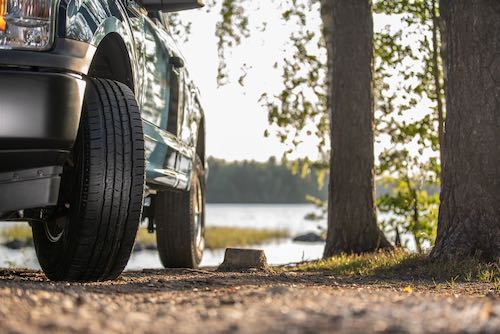Tires can help protect against hydroplaning. Innovations in car tires are made to help disperse more water while remaining traction on the road as hydroplaning is when a layer of water builds up between the tires of the car and the road leading to loss of traction, which causes the loss of control of the vehicle. In addition, to having good quality tires, the tires must be inflated appropriately with at least 4/32 inches of tread left on them to avoid hydroplaning. Hydroplaning causes many accidents, especially in the summer when sudden rain showers wet previously dry roads.
Most tires on the market today have tread patterns with grooves designed to help evacuate water and slush in the case of winter and all-weather tires. Tires like the Nokian WR G4 all-weather tires have the new “Blade Grooves” that help evacuate rain, snow, and slush from between the road and the tires. These grooves help disperse larger quantities of water so that water doesn’t build up between the road and tires. These grooves have been re-designed to accelerate the flow away from the main grooves. Having curved tread blocks additionally helps whisk away water to help maintain traction. You should note that hydroplaning can also occur with slush (melted snow). These properties are maintained even with reduced tread. Keep in mind when replacing tires, you should always replace all four tires at once as this prevents the lower-tread tires from spinning faster than the new ones.
The fact that tires can help prevent hydroplaning makes choosing good quality tires even more essential, so whether choosing an all-season tire, all-weather tire, or winter tire, make sure that the tires are good quality and have a tread pattern made to protect you against hydroplaning. In addition, you need to make sure that you keep the tires properly inflated and that you don’t let the tread wear down below 2/32 inches. It is recommended that you start looking to replace tires at 4/32 inches of tread left. Other things that you can do to reduce the risk of hydroplaning are avoiding puddles, using cruise control, and making sharp, quick turns or hard braking. It is also prudent to slow down your speed during rainy weather. If you find yourself hydroplaning with all these precautions, try not to panic, steer in the same direction as you were going, and don’t brake abruptly.
Manufacturers generally manufacture tires with innovations to protect against hydroplaning. As long as you have good quality all-weather, all-season, or winter tires with sufficient tread and air pressure, you will be better protected against hydroplaning. It is, however, essential to stay prudent when driving in the rain not only for the risk of hydroplaning but also as there is less visibility which in itself can be a risk for an accident. When driving in the rain, it is essential to reduce your speed, use the gears to downshift, slow down around turns and avoid standing water and puddles.
For more information regarding all-season tires, visit: https://www.nokiantires.com/
